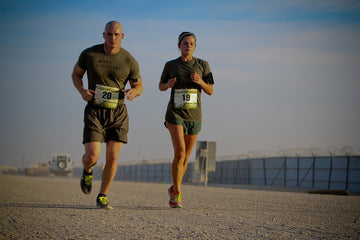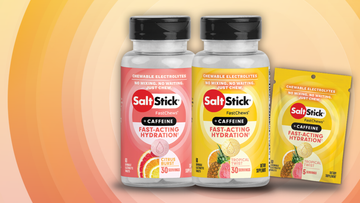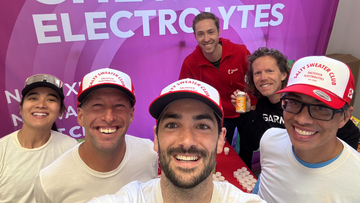
If you are an avid consumer of endurance media (like we are!) you have probably noticed the uptick in articles related to the science behind anti-cramping. Recently, many articles, including paid, native advertising placements in Triathlete Magazine and other articles in Outside Magazine, report new research into the link between cramping and neural activity. Arguing there is no association between hydration and cramping, the articles suggest that instead of electrolytes, the true cause of cramps is an interruption of “ion-channel receptors,” which control how electrical signals are transmitted between cells. “Some studies showed that drinking pickle juice or eating mustard helped prevent
The Beginning: Increasing worker productivity:
Early research into cramping had nothing to do with sports performance. In the 1930s, as the United States was boosting its infrastructure, scientists examined men working to build the Hoover Dam and discovered their sweat contained high levels of salt. Some of the men began drinking salt water, and anecdotal evidence suggested this was an effective measure of reducing cramps. This study formed the basis for the “electrolyte-depletion-as-a-cause-for-cramps” theory, which lasted for nearly the entire 20th century.
Theory takes hold, and Gatorade is born:
The connection between salt loss and cramping was further strengthened in the 1960s, when researchers at the University of Florida tested an electrolyte-and-sugar drink on the school’s football team. The next season, the Florida Gators won the Orange bowl, and Gatorade was born. Since then, the theory that dehydration is the main cause of cramping has been largely predominant. In fact, the Journal of Sport Rehabilitation reported in 2003, that “dehydration, humidity, and electrolyte imbalance” were the most common reasons for cramps offered by athletic trainers when surveyed.
Other studies examine the link between electrolytes and cramping:
Since the 1960s, researchers have sought to expound upon the link between cramps and low electrolyte levels. In general, they find that cramps are more likely to occur in hot weather, and the sodium levels in sweat of athletes who cramp are higher than those who do not cramp.- Low sodium levels: A 2005 study published in Medicine and Science in Sports and Exercise examined 18 Ironman triathletes, and found lower sodium blood-levels in the 11 triathletes that experienced cramping than the non-cramping athletes. However, the study, which controlled for finishing times and body weight, did not find significant differences between athletes for other electrolyte, glucose or hemoglobin levels. Also, a 2005 study in the International Journal of Sport Nutrition and Exercise Metabolism examined football players and found that regardless of sodium and water intake, the sodium content in sweat for cramp-prone players was more than twice as high as players who did not cramp. This study also did not find significant differences in levels of other electrolytes.
- High heat and humidity: Researchers from the Medical College of Georgia reported the results of a study involving tennis players who were prone to cramping in the Journal of Science and Medicine in Sport in 2003. The researchers noted that extensive sweating throughout previous matches was a significant predictor of cramps in the players. Many scientists also agree that cramps are an early sign of heat stroke.
Still others reveal non-electrolyte-based solutions:
Other research has focused on different methods to treat cramps, including drugs and products that contain acetic acid (the ingredient that gives vinegar its signature taste), such as pickle juice and mustard.- Anti-malarial drugs: Several studies have shown that quinine (a drug prescribed for pain, fever, or malaria, among other things) can significantly reduce the frequency of cramps. The Cochran database of systematic reviews published a summary of the literature in 2010 and concluded there is strong evidence for cramp-reducing potential of the drug. However, the researchers cautioned the medical community to consider potential side effects. Additionally, quinine is not prescribed for nighttime leg cramps, because the “risk of taking quinine for nighttime leg cramps may be greater than the possible benefits,” writes Drugs.com.
- Pickle juice: Endurance media is full of stories about how pickle juice makes a great at-home remedy for cramps, and much of this is based on a 2010 study out of Medicine and Science in Sports and Exercise. Researchers compared pickle juice, sports drinks and water as cramp remedies and found that pickle juice was the most effective. The researchers proposed that cramps are caused by overactive nerve signals telling muscles to contract, and the acidic pickle juice triggers a reflex when it hits a nerve center on the back of the throat. This reflex sends a signal to the nervous system to shut down the overactive neurons causing the cramp.
- Mustard: While there are not any scientific studies backing up its ability to reduce cramps, mustard appears in many anecdotes about at-home cramp remedies. While there’s no proven cause for mustard’s effectiveness in fighting cramps, some people have postulated that the acetic acid (contained in vinegar) prompts the body to produce more acetylcholine. Acetylcholine is a neurotransmitter that prompts muscles to work. Others argue mustard’s helpfulness is simply a placebo effect.
The shift away from electrolytes to neural activity:
As we mentioned in the introduction, since the 1990s, new research has focused more on neurological activity and muscular fatigue as the true reasons for cramping. Often, researchers will examine endurance athletes’ blood electrolyte levels and body weight changes (which measures fluid loss and serves as a “stand-in” for dehydration), finding no change between athletes that cramp and athletes that do not cramp (See this 2004 study in the British Journal of Sports Medicine for an example, as well as the studies listed below). Also, a 2012 literature review of magnesium as a cramp-prohibitor published in the Cochran database of systematic reviews concluded that there is not enough evidence to suggest that magnesium intake helps reduce cramping. These new studies have led researchers to conclude electrolyte levels are not significantly associated with cramping and instead propose other hypotheses. These non-nutritional causes include:- Faster race times: A 2011 study published in the British Journal of Sports Medicine examined 210 Ironman triathletes, finding no significant difference in blood electrolyte levels or body weight changes in the 43 athletes who experienced cramps and remaining athletes who did not. The researchers found that the only significant factor correlated with cramps was race times (i.e., the faster athletes were more likely to suffer from cramps). Note that the authors also found a personal history of cramping was a significant predictor, but this conclusion is fairly expected.
- Disrupted nerve signals: In addition to lower sodium levels, the 2005 Medicine and Science in Sports and Exercise study we mentioned above also found cramping Ironman athletes showed higher electromyography (EMG) levels in cramping muscles. EMG is used to assess the health of muscles and the nerve cells that control them, so higher EMG levels indicated a link between interrupted neural activity and cramps.
- Muscular fatigue: Another common theory is that cramping is the result of tired muscles. Several studies (Medicine and Science in Sports and Exercise, 1990; Journal of Sports Science, 1986) note that cramps usually occur toward the end of competitions.
Where do we stand today?
At the end of the day, no one is yet certain of the true causes for cramping. Despite the newer neurological-based literature, scientists are not ready to cast aside the role of hydration and electrolytes. In 2010, the Journal of Sports Health published a review that concluded “
Bottom line: Do electrolytes have anything to do with preventing cramps?
Based on the literature above, it is not unreasonable to assume electrolyte levels contribute little to preventing cramping. However, we cannot in good faith completely disregard the wealth of anecdotal evidence that proper hydration practices do work for some athletes. We have received many tweets and emails from amateur athletes over the years telling us that SaltStick has been a key ingredient eliminating cramps from their training. And we have heard personal feedback from college tennis coaches that SaltStick has been the only thing they can find to keep their athletes cramp-free. Additionally, many of the suggestions from researchers -- including stretching, strength exercises for muscular balance, and yes, hydration -- are just good practices. The smart athlete takes all steps to prepare for his or her race, and one of those steps is hydration. In his Endurance Planet interview, Maffetone was quick to mention that the scientific community still has not reached a consensus on cramping. “So many things come to mind







